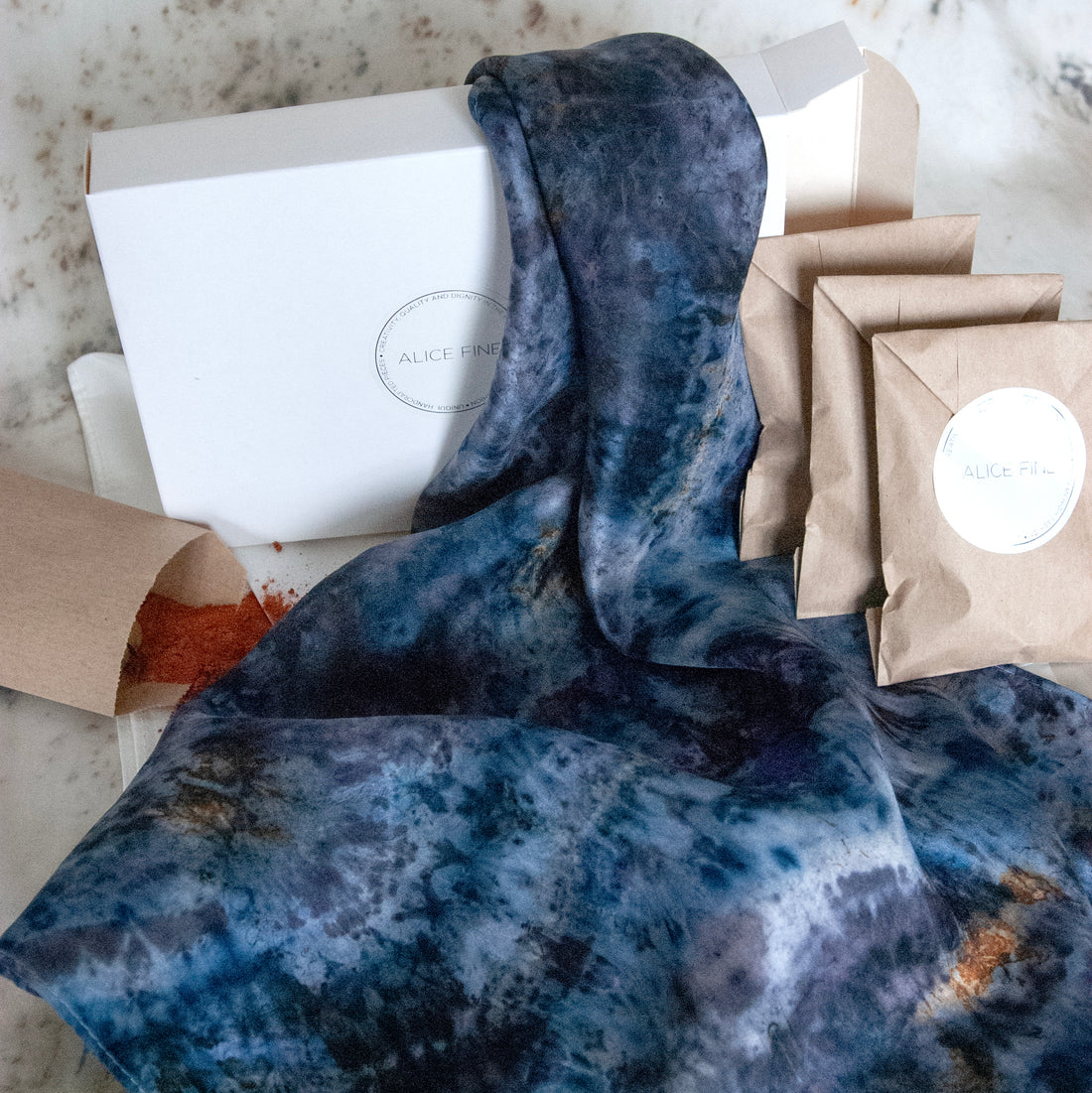Instructions for STARTER-KIT: Baby Blue Bundle Dye
This recipe originates from the book ”PLANT MAGIC – Batik, Bundle dye och andra tekniker för växtfärgning” (in swedish) but has been modified to better suit a smaller scarf. In the recipe, I use about 1 tablespoon of fresh, chopped red cabbage, which gives the beautiful lighter blue/turquoise color. However, it is not included in the starter kit because red cabbage is not suitable for shipping or drying. It's better if you acquire some fresh cabbage on your own!
Recepie:
-1 silk scarf
-1,2 g Aluminum Sulfate for mordanting, use 10% of the fabric's dry weight
-One tablespoon of sliced red cabbage. (this one is optional but adds a beautiful blue/turqouise)
-½ teaspoon Logwood
-½ teaspoon Oakgall
-A few strings of steel wool
(Note that there’s a bit more dyestuff included, then what’s needed in the recepie).
Instructions:
- Mordant the fabric by dissolving alum in some hot water in a pot. Fill with water to cover the scarf and gently heat in the water. Turn off the heat before simmering and leave for at least 2 hours, preferably overnight. Stir occasionally.
- Lift up the fabric and wring it out thoroughly.
- Spread it out flat.
- Place the red cabbage on the surface. Make sure to cover the entire fabric.
- Take a small pinch of brazilwood powder and sprinkle it evenly over the surface. (It's advised to wear a mask to avoid inhaling the powder.)
- Repeat with the oak gall.
- Take the steel wool and separate the threads to make them as thin as possible, then place a few pieces here and there on the fabric.
- Time to wrap it up! Scrunch the fabric slightly to avoid the pattern from being too evenly repeated. Then fold in the edges, roll into a bundle, and tie around.
-
Now it's time to heat the tied fabric, which helps the color to adhere to the fibers. Place the bundle in a pot with a lid, but keep above the water. Use a sieve or an old glass jar to place the fabric in/on. Steam/heat the fabric for at least 2 hours by gently bringing the water to a simmer and then turning off the heat. A temperature of around 40–60 degrees Celsius is good. Silk does not tolerate high temperatures well. Preferable, leave it overnight.
Alternatively, you can heat silk bundles with a warm wheat bag or hot water bottle overnight. Wrap them together in a thick towel or blanket to retain the heat. - After heating: Open the bundle, brush off the fabric, and wash it by hand or in a hand wash program in the machine. Use about 1/2 teaspoon of fine detergent or silk/wool soap to neutralize the colors.
-
Last but not least, iron the fabric to remove any wrinkles. This also helps to further fix the pigments in the fibers and gives the silk its shiny, luxurious luster!
Best of luck!
Let me know if you have any questions.
/Karin Alice Bjurström
info@alicefine.com
Instruktioner för STARTER-KIT: Baby Blue Bundle Dye
-
Detta recept kommer från boken "PLANT MAGIC - Batik, Bundle dye och andra tekniker för växtfärgning", men har modifierats för att passa en mindre scarf. I receptet använder jag cirka 1 matsked färsk, skuren rödkål i färgningen, vilket ger den vackra ljusblå/turkosa färgen. Rödkålen ingår dock inte i start-kitet eftersom den inte lämpar sig att skicka med posten eller torka. Det är bättre att du själv införskaffar lite färsk!
Recept:
-1 sidensjal
-1,2 g alun för betning, 10% av tygets torrvikt
-Ca en matsked skuren rödkål (detta är valfritt men ger en vacker blå/turkos färg)
-½ tsk Bresilja
-½ tsk Galläpple
-Några strängar stålull
(Observera att det finns mer färgämne i paketet, än vad som behövs i receptet).
Instruktioner:
-
Beta tyget genom att lösa upp alun i lite hett vatten i en gryta. Fyll på med vatten så att det täcker sjalen och värm den försiktigt i vattnet. Stäng av plattan innan det börjar sjuda och lämna minst 2 timmar, men gärna över natten. Rör om då och då.
-
Lyft upp tyget och vrid ur det ordentligt.
-
Bred ut det platt.
-
Placera ut rödkål på ytan. Se till att täcka hela.
-
Ta en liten nypa bresilja pulver och sprinkla jämt över ytan. (Använd gärna munskydd så du inte andas in pulvret.)
-
Gör samma sak med galläpple.
-
Ta stålullen och drar isär trådarna så de blir så tunna som möjligt och placerar ut några stycken här och där på tyget.
-
Dags att knyta ihop färgningen! Nypa och skrynkla ihop tyget lite för att undvika att mönstret blir för jämnt repeterat. Vik in kanterna, rulla ihop och knyt om.
-
Fixera; Nu är det dags att värma knytet vilket hjälper färgen att fästa i fibern. Lägg knytet i en gryta med lock, men ovan vattenytan. Använd en sil eller en gammal glasburk att lägga knytet i/på. Ånga/värm knytet minst 2 timmar genom att sjuda upp vattnet försiktigt och sedan stänga av plattan. En temperatur runt 40–60 grader är bra. Siden mår inte bra av för hög temperatur. Lämna gärna över natten.
Man kan också värma sidenknyten med en varm vetekudde eller varmvattenflaska över natten. Linda då in dem tillsammans i en tjock handduk eller filt för att bevara värmen. -
Efter värmning: Öppna knytet, borsta av tyget och tvätta sedan ur för hand eller med handtvätt- program i tvättmaskin. Använd cirka 1/2 tsk fintvättmedel eller galltvål för att neutralisera färgerna.
-
Sist men inte minst, stryk tyget för att få bort alla skrynklor. Det hjälper också till att ytterligare fixera pigmenten i fibern och ger sidenet sin blanka, lyxiga lyster!
Lycka till!
Hör av dig om du undrar något./Karin Alice Bjurström
info@alicefine.com
-

